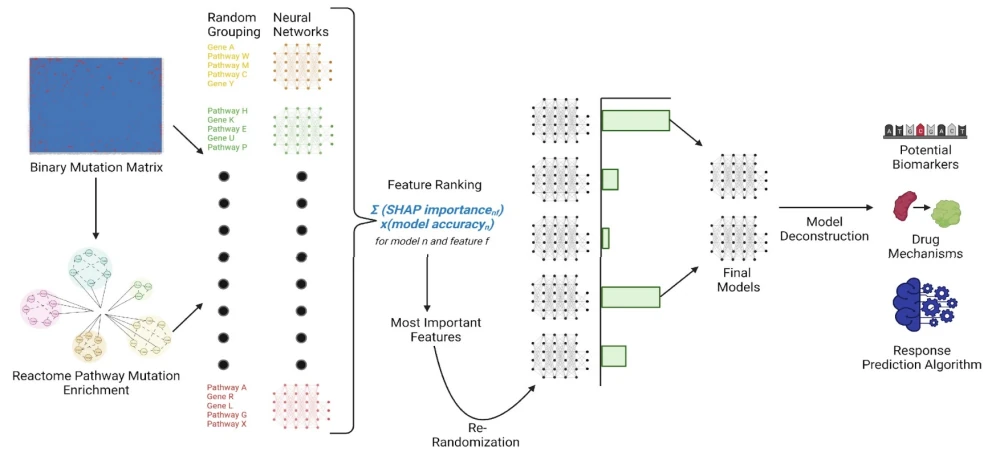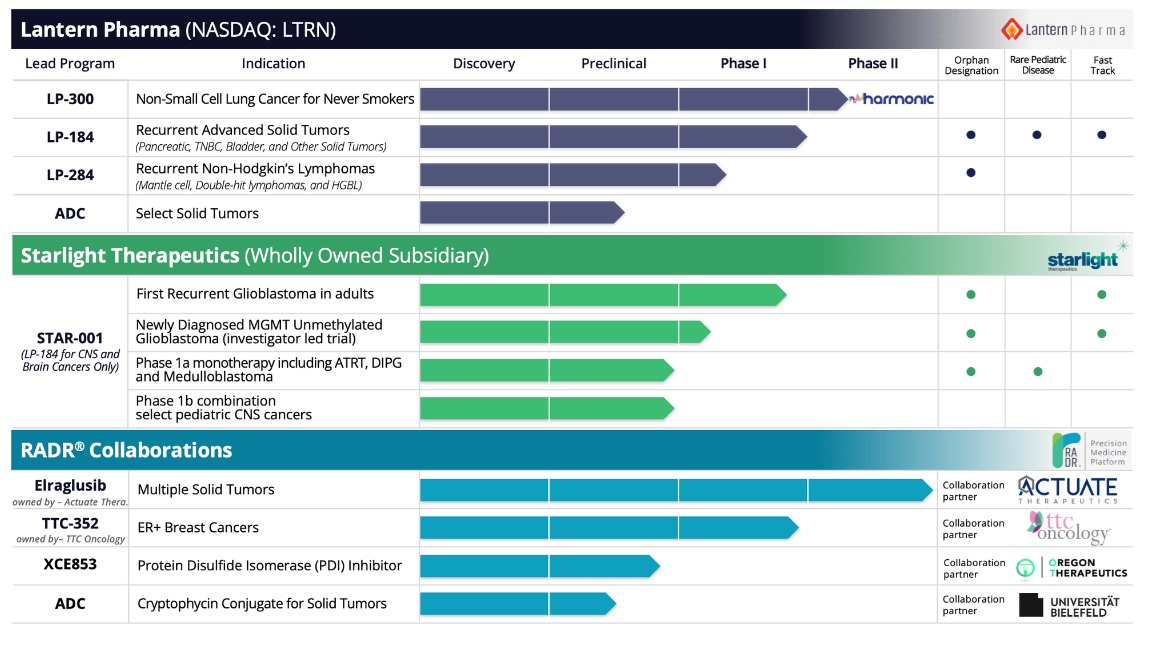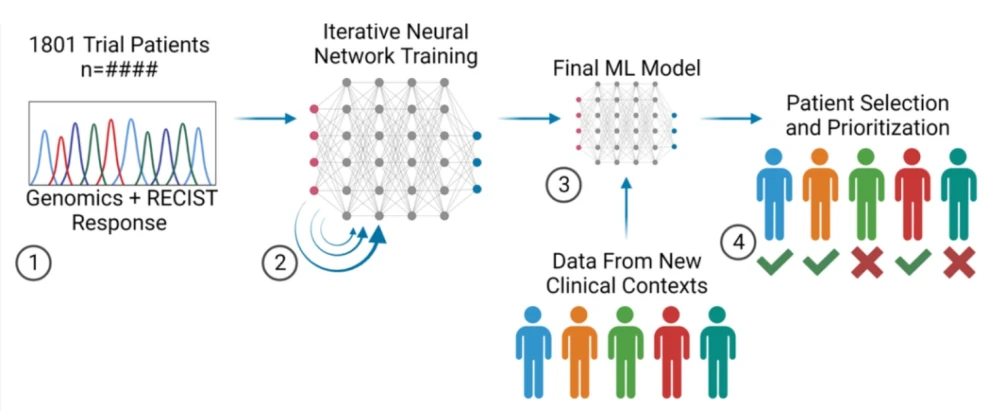AI in Bio • Sponsored by Lantern Pharma
How Lantern Pharma's AI-driven Approach Enables Precision Oncology
Lantern Pharma’s AI-driven drug discovery platform RADR® enables value creation across multiple dimensions of the oncology drug development process: from the expansion of therapeutic indications and the identification of drug combinations for use in precision oncology, as well as the creation of patient response signatures or biomarker profiles that can be used to increase the success of a clinical trial.
The process of creating new cancer treatments is fraught with numerous roadblocks, significantly impacting their efficacy and slowing the rollout of successful therapies. The sobering reality is that a staggering 97% of potential oncology drugs fall short of ever being introduced to the market, according to estimations by Wong, Siah and Lo, 2019. This failure rate is largely due to the intricate interplay of genetic targets, unexpected surges in patient drug resistance, and the predictive limitations of our current preclinical models. Further complicating matters, successful drugs often yield only marginal survival benefits for patients.
Clinical trial design is also problematic, often testing drugs indiscriminately across various cancer types, without considering the specific genetic implications of the drug. According to a 2021 study ‘Does biomarker use in oncology improve clinical trial failure risk? A large‐scale analysis’, clinical trials designed without integration of relevant and informative biomarkers are 12 times more likely to fail.
According to a 2024 review of FDA approvals from 2011–2023, nearly half of accelerated approvals (48%) and 40% of regular approvals were granted for biomarker-defined populations, underscoring how biomarker-driven approaches are increasingly central to oncology drug development and more likely to streamline trials toward successful outcomes
The Dire Need for Progress in Oncology Drug Discovery
The gambling-level failure rate of current oncology drug discovery programs in clinical trials can be attributed to multiple complex factors. A prominent challenge is misunderstanding a drug's efficacy, often due to unanticipated off-target effects, which obscure the drug's true mechanism of action (MOA). For instance, this confusion can result in the mischaracterization of target-specific inhibitors, a complication exemplified by the maternal embryonic leucine zipper kinase (MELK) inhibitor OST167. Despite MELK being identified as crucial in multiple cancer types, it was found to be nonessential for cancer cell fitness, which likely contributed to the misunderstanding. Further confusion arises from the misidentification of biomarkers, which hinders the determination of a drug’s true target. Studies like Lin et al. (2019) have also demonstrated that certain proteins, including MELK, HDAC6, MAPK14, PAK4, PBK, and PIM1, initially thought to be essential for cancer, are in fact nonessential for cancer cell survival, thereby adding another layer of complexity to the drug discovery and approval process.
An indiscriminate approach to oncology clinical trials may dilute the effectiveness of the trials and miss potential opportunities. The drug sorafenib provides a vivid example of the surprises in cancer drug development. It was initially expected to work by inhibiting the BRAF gene, but tests in melanoma, where BRAF mutations are common, didn't yield a survival benefit. Instead, the drug exhibited potency in blocking VEGF, a molecule that regulates blood vessel growth. This led to its FDA approval for treating kidney, liver, and thyroid cancers.
The complexity and diversity of cancer's genetic landscape, along with the challenge of drug resistance, have a substantial impact on the progress of successful cancer therapies. Take, yet another example, the once-promising drug Avastin. Initially approved for metastatic breast cancer in 2008, it was later revoked by the FDA in 2011 due to a lack of evidence in extending patient survival and mitigating tumor growth.
These challenges highlight the pressing need for a more sophisticated strategy in cancer drug development and clinical trial design—one that is capable of intelligently addressing genetic diversity, anticipating drug resistance, and optimizing therapeutic allocation.
Enabling Precision Oncology with RADR® AI Platform
Since its inception in 2014, a Dallas-based clinical-stage biotech Lantern Pharma has been focused on improving standards of care for cancer patients by expanding therapeutic indications space, identifying combination therapy opportunities, and designing more focused and cost-efficient clinical trials with precision-based patient selection strategies. To achieve the goals, Lantern Pharma leverages an artificial intelligence (AI)-first approach through its RADR® platform.
RADR® exploits machine learning for identifying mechanisms of action (MoA), driving preclinical development of oncology assets, identifying novel therapeutic indications, and discerning and predicting patient responses to specific drugs. Engineered to deeply analyze genomic and transcriptomic data derived from both clinical and preclinical studies, RADR® is a solution that illuminates the complexities of genetic heterogeneity in cancers and patients.
Cancer's genetic diversity often complicates the identification of patient groups likely to respond favorably to a given drug in clinical trials, leading to endpoints that may lack statistical significance and hamper the demonstration of clinical benefit for regulatory approval. RADR® is designed to address this challenge, aiming to reveal the most suitable patient groups for specific therapies.
Utilizing transcriptomic, genomic, and drug sensitivity data from multiple sources, RADR® analyzes over 25 billion clinical data points, more than 154 drug-tumor interactions, and 130,000+ patient records across 17 databases. The platform embraces datasets from public resources, commercial clinical studies, and Lantern's ex vivo 3D tumor models to draw correlations between genetic biomarkers and drug activity. This end-to-end process transforms multi-omics data into an optimal model that predicts drug responses, generating candidate biomarkers and aiding in patient stratification for clinical trial design.

Image credit: Lantern Pharma. The company’s AI-driven drug discovery platform RADR®.
As the company notes, RADR® platform isn't just about refining patient selection; it's also about risk mitigation and success optimization in drug development. By segregating patients into likely responders and non-responders for various oncology therapies, RADR® enhances the potential to de-risk clinical trials and augment the likelihood of FDA approval. This strategic patient enrichment not only streamlines clinical trials, potentially reducing research costs and hastening the delivery of crucial new therapies but also paves the way for personalizing cancer treatments and potentially improving patient outcomes.
Furthermore, RADR®'s operational workflow is flexibly adapted for a range of drug candidates: those in early stages to help define indications, combinations or targeted effective doses; late-stage or shelved clinical drug candidates to help identify the most likely to respond favorably; and currently marketed or generic drugs for a new or different cancer indication on a defined patient population.
A Battle-tested AI Platform for Precision Oncology
Speaking in terms of actual results, Lantern Pharma’s AI-guided LP-184, a synthetic lethal small-molecule prodrug, met Phase 1a endpoints in 63 patients with relapsed/refractory solid tumors, demonstrating favorable safety, early antitumor activity, and biomarker-driven benefit in DNA damage response–mutated cancers, paving the way for targeted Phase 1b/2 trials..
Earlier this year, Lantern Pharma reported on its Q2 2025 progress, noting that LP-284, its candidate for non-Hodgkin’s lymphomas, achieved a complete metabolic response in a patient with relapsed, refractory disease and continues to show promise across hematologic malignancies; LP-300, being evaluated in the HARMONIC trial for never-smoking NSCLC patients, demonstrated encouraging activity and is being explored in biomarker-defined subgroups. On the AI front, Lantern expanded its RADR platform to over 200 billion oncology data points, launched PredictBBB.ai to model blood–brain barrier permeability, and introduced a drug combination prediction module to accelerate rational therapy design. Financially, the company closed the quarter with $15.9 million in cash, providing a runway into mid-2026.
Interestingly, Lantern Pharma has a subsidiary, Starlight Therapeutics, fully dedicated to developing therapies for central nervous system (CNS) and brain cancers. In August 2025, Starlight Therapeutics announced U.S. FDA clearance of an IND for the Phase Ib/2a Glioblastoma Multiforme (GBM) Trial.

Image credit: Lantern Pharma. The company’s oncology pipeline, enabled by AI-driven drug discovery platform RADR®.
Advancing Oncology Drug Discovery Through Partnerships
To summarize, Lantern Pharma provides a novel solution to the often challenging landscape of oncology drug development. Their proprietary RADR® platform employs a blend of genomics and artificial intelligence-based methods to repurpose and reinvigorate clinical-stage drugs that have been previously discontinued. By identifying and validating biomarkers for patient response, Lantern Pharma aims to enhance the potential value of these treatments, providing a potentially lucrative opportunity for partners looking to optimize their oncology pipelines and potentially resurrect failed drug candidates.
Rather than originating drugs from the ground up, Lantern Pharma takes a strategic approach by focusing on late-stage clinical drugs that demonstrated efficacy in certain patient groups but were otherwise discontinued. Utilizing advanced genomics, data analytics, and AI, they 'rescue' these valuable drugs and reorient them towards the specific patient groups identified through molecular profiling. This process allows for stratified and efficient patient treatment within focused clinical trials, including Lantern Pharma's ongoing collaboration programs.
From earlier examples, Lantern Pharma’s RADR® AI platform managed to predict Elraglusib’s response to metastatic melanoma, resistant to checkpoint inhibitors, with 88% accuracy -- for a group of 26 patients.

Development of a Machine Learning Model to Predict Patient Elraglusib Response with Genomics Input.
Image credit: From ASCO 2023 poster #3079.
Upon the successful repurposing of a drug and the identification of a diagnostic biomarker for drug response, Lantern Pharma opens up opportunities for licensing or partnerships. Their strategy fosters the development of precision therapies while simultaneously addressing significant unmet needs in the oncology market, positioning Lantern Pharma as a promising partner for organizations looking to optimize their oncology development strategy.
Topic: AI in Bio